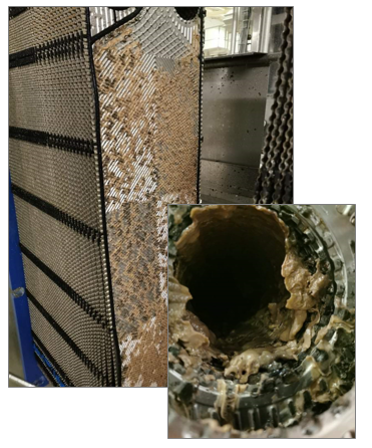- Industry: Food Processing
- Application: Pasteurizer heat transfer
- Problem: Loss of production due to biofilm and biomass fiber fouling of heat transfer equipment.
- Solution: Periodic clean-in-place (CIP) treatment with bioeXile-L for the dispersion of the biofilm / fiber matrix.
- Results:
Cost Savings
£39K Overall savings by eliminating productivity lossLabor Cost Savings
70% Reduction in cleaning frequency and labour costs
Condition
A UK soft-drink manufacturer using natural fruits for a flavored soft-drink had a history of frequent blockages in the Tetra Pak plate heat exchanger, due to fibrous fruit components building up and blocking the pasteurizer exchanger. Biofilm growth acted as a glue to exacerbate this problem and potentially affect product quality. This caused the pump amperage draw to increase, forcing shut-down and reactive mechanical cleaning procedures approximately 10 times a year. Greater uptime was required.
Chem-Aqua Solution
Bench tests were performed on samples using various Chem-Aqua solutions. It was found that bioeXile-L in particular was visibly effective at dispersing the fruit fibers from the challenging samples. bioeXile-L is a patented biofilm removal product that disrupts the structure of biofilm, allowing biocides to be more effective thus ensuring a deep system clean.
This is a key element of Chem-Aqua’s Get Clean, Keep Clean 360ᵒ approach to biomanagement.
bioeXile L is a liquid NSF rated product, which makes it perfectly suitable for clean-in-place operations in the food and beverage industry.
Operations staff were provided training on biofilm and bioeXile-L application. They are now successfully applying bioeXile-L as a routine CIP step to successfully control biofilm growth and fruit-fiber blockages.

Results
Decreased shutdown and cleaning requirements from 10x per year down to just 3, resulting in substantial savings of cleaning time, labor costs and production loss.
Contact Us Today
Transform your water treatment strategy with aquaDART™ and experience unparalleled control, efficiency, and cost savings. Reach out to our team at Chem-Aqua to discuss how aquaDART™ can elevate your water system performance.

